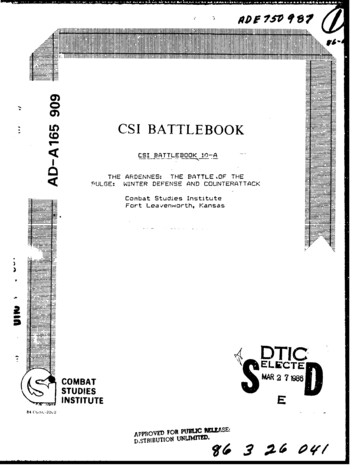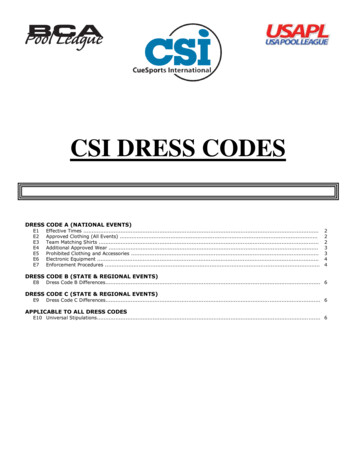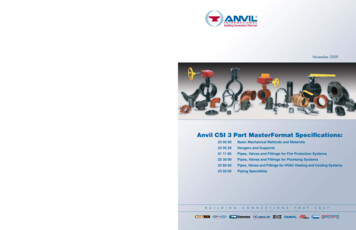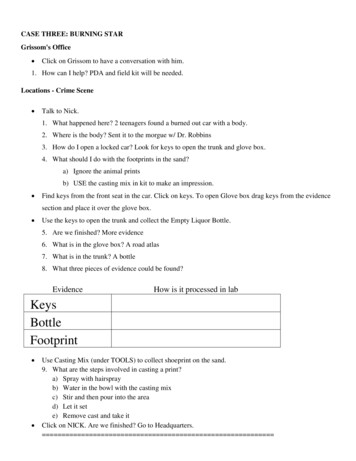
Transcription
Apr131e00)CSI BATTLEBOOKCSI BATTLEBOOK1O-ATHE PATTLEOF THETHE ARDENNES:AND COUNTERATTACKDEFENSEWINTERrULGE:Combat Studies InstituteFort Leavenworth, KansasDTICELECTEMAR 2 7 86COMBATSTUDIESWý4INSTITUTE84 CU-3 2tL -JAPP1OV'I FOR pM ICDSIRIBUTION UNLtWF.fi0"SE:
CSI BATTLEBOOK10-ATHE ARDENNES:THE BATTLE *OF THEBULGE:WINTER DEFENSE AND COUNTERATTACKCombat Studies InstituteFort Leavenworth, KansasDTIC ELECTEh'N "b l b[04US i Dr;'': .'; !?: IitU':.CEA5E:rijU11t L.A v1r7 i985u
SECURITY CLASSIFICATION OF THIS PAGE (When Date Entered)REPORT DOCUMEHTATiOPAGE--READ INSTRUCTIONSBEFORE COMPLETING FORUMREPORTDOCUMENTATIONPAGEI.REPORT NUMBER2. GOVT ACCESSION No.24.A ,ITLE (end Subtitle)The Ardennes: The Battle of the Bulge:'.!inter Defense and Counterattack7.3.RECiPiCNT's CATALOG NUMBERS.TYPE OF REPORT & PERIOD COVEREDStudent PaperPERFORMING ORG. REPORT NUMBERS.AUTH"j,8,r. CONTRACT OR GRANT NUMBER(*)KuOR *jfJohn T. iLitchfteld, NIAl-Paul F.;Barb99)*Thomas F1.Burrell, WthaC. Cumberworth,ARes eRlt ý'Flanagan, MAJ Michael J. Forsy'th(cbntinied ove'r)9.PERFORMING ORGANIZATION NAME AND ADDRESSI0. PROGRAM ELEMENT, PROJECT. TASKAREA & WORK UNIT NUMBERSCombat Studies Institute, USACGSCATTN: ATZL-SWI, Ft Leavenworth KSI1.66027CONTROLLING OFFICE NAME AND ADORESSREPORT DATEMay 1 984 . NUMaEy 1FPAGS82USACGSC, ATTN:KS 66027Combat Studies Institute,ATZL-SWI, Ft Leavenworth14.12.MONITORING AGENCY NAME & ADORESS(It dillarent lrom Controlllng Office)IS. SECURITY CLASS. (of thie INGSCHEDULEDISTRIBUTION STATEMENT (of th.e Report)Approved for public, release;distribution-unlimited17.DISTRIBUTION STATEMENT (ol the abestect entered In Block 20, It different from Report)1.SUPPLEME-NTARYNOTESA battlebook prepared by students of the US Army Copriand and General Staff Collegeunder the supervision of the Combat %tudies Institute.Hi Story, Case Studies,Military Operations. Tactical Analysis, Battles, Military Tactics, Tactical 'rWarfareInfantry, Defense, counterattack.Free Term, : Winter warfare, Ardennes,Belgium, Germany.19.KEY WORDS (Continue an reverse sid. It nece sary and Identity by block number),rAfTRZACT (Cau rthuere.re.fft rt.tyeasra IdentlfIby block number)Tactical analysis of one aspect of the southern shoulder of the battle of theBulge, when the German 212th Volksgrenadier Division attacked the US 4th InfantryDivision in the area of Luxembourg City during December 1944.US local counterattacks beginning on the second day of the battle (17 Cecember) forced theGerman 80th Corps onto the defensive, blocking' the southern side of the Bulgejust as the 7th US Armored Division held thenorthern side at St Vith.DDFORLSu12JANDO1473EDITION Or NOV 6S IS OrSOLETE-AS TrLSECURITY CLASSIFICATION Gi THIS PAGE (WhenDate Enlteed)
7. Authors, con't: COL Mahmoud M. Hegazy, MAJ Virgil L. PackettII,MAJ Wayne R. Pembrook, MAJ Thomas G. Raseta, MAJ Rodney G.Thomas.Accession ForNTISGRA&IPTIC ility CodesAvail arid/orDistSpecialr"N AI. /,GC-,r -APtwp""ý -ýP
THE LUNITED STATES ARMY COMMANDAND GENERAL STAFF COLLEGETHEWINTERTHE ARDENNES:BATTLE OF THEDEFENSEANDBULGECOUNTERATTACKUNITED STAIES 4TH INFANTRY DIVISION, VIII (US) CORPSVS.DEUTSCHES REICH 212TH VOLKSGRENADIER DIVISION, L)O0( CORPS16 DECEMBER 1944 -MajorMajorMajorMajorMajor3JANUARY1945Prepared by Staff Group A, Section 10Major John T. LitchfieldColonel Mahmoud Mohammed HegazyPaul F. Barb, Jr.Major Virgil L. Packett, IIThomas F. BurrellMajor Wayne R. PembrookCharles C. CumberworthRoosevel t FlanaganMajor Thomas G. RasetaMichael J. ForsythMajor Rodney G. ThomasSubmitted to the Combat Studies Institute,United State Army Command and General Staff Coll.egeIn Fulfillment of the Requiremeits forSubcourse P651, Battle AnalysisFo,-t Leavenworth,(.MayA-I. Kansas1984A&AA-"
CO"tON REFERENCE: ARDENNESTYPE OPERATION: Defense and Counterattack, WinterOPPOSING FORCES: U.S.:4th Infantry Division, VIII CorpsCCA, 10th Armored DivisionGerman:212th Volksgrenadier Division, LXXY CorpsSYNOPSIS: The 4th Infantry Division had lost 7,500 casualties in theHuertgen Forest before moving into the Ardennes for a restin early December, 1944. It was deployed with three understrength regiments on line, but only the northernmost(le-thand) regiment, the 12th Infantry, was hit by the leftflank of the German offensive on 16 December 1944. The Germanforces in this area had no priority on bridging, artillery, andheavy weapons, and, therefore, were unable to exploit theirinitial surprise and wipe out s.trviving outposts of the 12thInfantry. Thereafter, the 4'a conucuted a series of localcounterattacks on 17-19 December, forcing the German LXCO Corpsinto the defensive, setting up later counterattacks conductedby the 4th Infantry Division and other units coming fromPatton's Third Army. Thus the 4th Infantry held the southernshoulder of the German penetration, Just as the 99th Infantryand 7th Armored Divisions held the northern shoulder.BIBLIOG.RAPHY:The Ardennes: Battle of the Bulge.The United States Armyin World War II, by Hugh M. Cole.bLAitter Woods, by John S.D. Eisenhower.Hitler's Last Offensive, by Peter Elstob.by John Toland.The Story of the Bljujolattlt:A'i -*r.t1'r
OF CO N-TSSTASLESECTIONI:Introduction.Source Docum-ents .The Strategic SettingSECTION II:SECTION III: The Tactical13. 5SituationThe Area of OperationsThe Opposing Forces .14.19Immediate Military Objectivesand Courses of Action.39SECTION IV: Description of the Action .Day .Engagements on the FirstEngag ements of the Second Day .Second Phase of the Battle.Actions on 20 December .Detente to Offense.FinalEpilogueAssumptionofto the BattleDescriptionInitiative.of Key Elements6162.64. .67Significance of the ActionIfrmediate.*. .Long-Term .Lessons LearnedSELECTED4549525860Enemy Attacks andU.S.SECTION V:43BIBLIOGRAPHY.687078MAPS AND FIGURESMap A : The Ardennes Counteroffensive .map B : rhe Seventh Army Attack .Figure 3-1: The Chains of Command .ii I.134231
SECTIONINTRODUCTIONIITO THE ARDENNESaBATTLEOF THE BULGEBy November 1944 Allied armor had raced across France and was approachingthe pre-1940 German borders. Eisenhower had decided in favor of a broad frontalattac rather than a narrow thrust. He ordered an offensive in November designedto destroy all German forces west of the Rhine, the establishment of bridgeheadsover the river, and an advance into Germany. General Bradley's First and NinthArmies attacked into heavy opposition over difficult terrain to enlarge thebreakthrough at Aachen. The Muertgen Forest was the primary obstacle. Bradley'sattack was successful in that it reached the Roer River, but he was forced todelay crossing until forces could seize the Schmidt Dams. The dams were locatedup-river from Allied positions and posed a threat as long as they were in Germanhands.The U.S. 4th Infantry Division attacked into and through the mostdifficult and heavily defended part of the Huertgen Forest.sLu.ceeded, but was rendered nearly combat ineffective.The divisionIn less than a month thedivision had sustained more than 5,000 battle casualties and over 2,500 non-battlelosses: approximately one half the division's strengLh of approximately 16,000soldiers.Losse- were highest in combat units with some emerging from battle atlest than 50 percent of combat strength. Equipment and supply losses were equallyhigh.The 4th Infantry Division needed a rest and reconstitution to return it tofighting condition.On I December 1944, General Hodges, Commander of the First U.S. Army, incoordination with General Bradley,12th Army Group Commander, (and the VII andVIII U.S. Corps commanders), arranged to move the 4th Infantry Division into theI
alleged "quiet" sector of the VIII Corps area, then occupied by the 83rd InfantryDivision.Major General Raymond 0. Barton, the 4th Division Commander, was soinformed orally that evening. The 4th Division consisted of three regiments, the8th, 12th and 22d.On 3 December the Division issued the movement order. Based on the staffcoordination between the two divisions, the southern flank would be changed first,then the northern flank, and finally the center sector. VII Corps issued MovementOrder Number 4 on 4 December 1944 reflecting that exchange sequence.Infantry Regimentmoved on 4 December, followed by the 12th Regiment and divisiontroops on 8 December, and the 8th Regiment on U2 December.from VIIThe 22dThe division passedto VIII Corps control upon the closure of the 22nd Infantry. By theevening of 13 December,the 4th Infantry Division occupied positions along a 35mile front with its left flank adjacent to the 9th Armored Division, and its right* flank securing the boundary between the First and Third Armies.Of the three regiments. only the i2th Infantry stood in the path of theplanned German offensive.The advances in the 12th's sector were not, however,intended to be part of the German main effort. They were designed as localattacids to seize and hold the terrain necessary to secure the southern shoulder ofa larger penetration. The 12th Infantry occupied outposts on the Sauer River, perMG Barton's orders, while the main positions were located on the ridges and hillsoverlooking the river.The 212th Volksgrenadier Division (VGD) and assorted other units faced the4th Infantry Division.The 212th had been mauled while fighting on the easternfront, and after a rest and refit in Poland had been sent to the western front for"blooding" of its many replacements.(At this time Germany's best units andsoldiers were not fighting on the western front as the main threat to Nazi Germanywas in the eastJThe 212th VGD, now at full strength, was rat U2Idsthe best
division inthe German Seventh Army, and because of its reputation, preparedness,and high morale, was assigned the mission of protecting the Army's southern flank.The primary goal of the 212th VGD was tc break through U.S. lines andconduct a turning movement centered on the town of Echternach.intelligence,the 212thDue to excellentVGD knew it was opposed by only the 12th Infantry.The!2th Infantry Regiment's eight days of rest and relaxation came to an abrupt endin the early hours of 16 December 1944.SOURCEDOCUMIENTSSources for the analysis consist of one book and various other documentsand records maintained in several different archives.magnificent workp The Ardennes:BattleQf.theDr. Hugh H. Cole'sSul e, a volume in theextensive U.S. Army in World War II "GOr-en Book" series, presents the wholespectrum of the Ardennes Offensive. Chapter 10 of this volume is the mostimportant and accurate story of the 4th Infantry Division fight. Of the severalbooks written by civilians, none discusses the 4th Infantry Division asextensively as Cole's. Robert E. Xerriam's Dark December, JohnToland's Bajttle:ThSrojeBuand John Eisenhooer's TheBit ter Woodsare all excellent overviews of the entire Battle of the Bulge.but do not discuss the 4th Infantry Division in sufficient detail.In 1947 Colonel Gmerden F. Johnson published a work titled Hi story ofthe 12th InfantrT Reiment in World WarI.Unfortunately, itisnotreadily available for even the serious historian. 4th Division after action"neports (AAR) are a ready source of information, as are the daily division staffjournals. The AAR offer excellent narrative accounts. The journals alone present3
a fragmen "d, difficult to follow picture, but are good as companions to the AAR.The 9th and 10th Armored Divisions also published excellent AAR. These reports,in conjunction with their respective division journals, are good sources forclarification of those parts of the battle in which elements of the threedivisions participated simultaneously.Extensively indexed American and German oral histories are available in theOffice of the Chief Military History (OCMH), Department of the Army. The besisource for unit histories is the extensive collection of the New York PublicLibrary, the OCMH, and the Army library in Carlisle, Pennsylvania.It may be possible to conduct current oral history intervmews. This avenuewas not explored, however, due to the short time available for this project.Travel considerations for the interviewee and/or interviewer also made this methodimpractical.4
SECTIONTHE STRATEGICIISETTINGIn literary circles, especially drama, the climax of a work may coie longbefore the final act.campaigns.It may be said that much the same is true in militaryHindsight has shown this to be true.In the American Civil War,historians now agree that the Battle o4 Gettysburg was perhaps the climax of the war.Yet this battle was fought in 1863, while the end of the war was not to come for twomore years.As Stephen Vincent Benet said, "All roads now lead to Appomattox." (2:19)So it was with the Allied invasion of the European continent.The climax inthat campaign, and indeed in the war, came in December 1944 when Hitler launchedhis great o4fensive known as the Battle of the Bulge.Thiugh this great fight camein midwinter and at the turn of the year, much fighting and dying was still to come.But from the time the German offensive stalled and was contained, the outcome of thecampaign for the recapture of the continent was no longer in doubt.The Allied advances in November, although they brought the Allies closer tothe Rhine, had not lived up to expectations.Considerable damage had beeninflicted upon the hard-pressed Germans--in November and early December the
UNITED STAIES 4TH INFANTRY DIVISION, VIII (US) CORPS VS. DEUTSCHES REICH 212TH VOLKSGRENADIER DIVISION, L)O0( CORPS 16 DECEMBER 1944 - 3 JANUARY 1945 Prepared by Staff Group A, Section 10 Major John T. Litchfield Major











